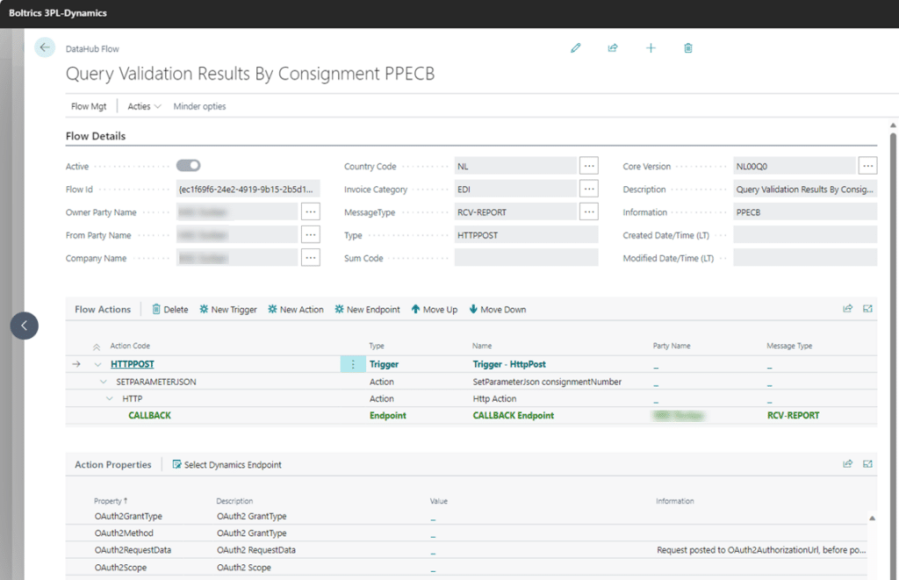DataHub 2.0: integreren met uw logistieke software was nog nooit zó eenvoudig
Realtime track & tracing, automatische klantcommunicatie en data-gedreven werken zijn essentieel voor succes en onderscheid in de logistieke sector. Dit vereist integraties die systemen met elkaar laten communiceren zonder extra handelingen van medewerkers, om efficiëntie te behouden. Daarom ontwikkelde Boltrics in 2018 DataHub, een alles-in-één integratieplatform. Met de nieuwste versie wordt samenwerken met externe systemen nog eenvoudiger.

Het ontstaan van DataHub
In 2018 begon onze partner Boltrics met het ontwikkelen van het zogenoemde DataHub-platform om EDI integraties mogelijk te maken. In de jaren die volgden is dit integratieplatform gegroeid van 3000 transacties per jaar naar ruim 19 miljoen transacties in 2023. Met inmiddels meer dan 350 partijen waarmee de koppeling standaard beschikbaar is in 3PL Dynamics. Van AFAS tot Shopify en van Transsmart (nShift) tot Portbase.
DataHub 2.0 in een notendop
DataHub was de afgelopen jaren dé manier om uw logistieke software te integreren met systemen van uw klanten, boekhoudpakketten, webshops en nog veel meer. En met succes. Maar om aan het steeds sterker wordende integratievraagstuk te voldoen, is Boltrics van start gegaan met het ontwikkelen van een nieuw DataHub-platform: DataHub 2.0. Dit nieuwe platform vergroot de flexibiliteit van uw integraties, biedt meer inzicht in uw stromen én zet uzelf in de driver seat.
Integraties opzetten als puzzelstukjes aan elkaar leggen
Het grootste verschil tussen de huidige en de nieuwe versie van DataHub is de flexibiliteit in het opzetten van uw communicatiestromen. Waar DataHub nu nog gebonden is aan één vaste structuur voor iedere stroom, zijn de stromen via DataHub 2.0 opgebouwd uit losse componenten die aan elkaar gelinkt kunnen worden. Als het in elkaar leggen van verschillende puzzelstukjes. Simpel en snel.
Een complete integratiestroom in één scherm configureren
Met deze opzet van DataHub 2.0 wordt het opzetten van een communicatiestroom een stuk eenvoudiger. Zowel voor onze integratieconsultants als voor u. Alles gebeurt namelijk in één scherm. Direct zichtbaar in uw 3PL Dynamics omgeving. Dus wanneer uw key-users thuis zijn in de wereld van integraties, kunnen zij zelf in no-time een nieuwe integratie opzetten. In dit scherm kiest u namelijk eenvoudig uit welke puzzelstukjes de integratie moet bestaan. Wat is de ‘trigger’, wat zijn de uit te voeren ‘acties’ en wat is het ‘endpoint’? Allemaal flexibel te selecteren en met één druk op de knop live.


Overzichtelijk foutmeldingen analyseren en oplossen
Daarbij kan er bij onverhoopte foutmeldingen snel worden gehandeld, doordat uw stroom overzichtelijk is opgebouwd uit triggers, acties en endpoints. Het is namelijk direct zichtbaar in welke van deze componenten er een fout optreedt. Waardoor deze snel opgespoord is en dus snel opgelost.
Klaar voor de toekomst met DataHub 2.0
Met de nieuwe opzet van DataHub is het integratieplatform klaar voor de toekomst. Maar daarbij maakt het ook de weg vrij om andere innovaties uit te rollen. Waaronder Packaged Integrations. Waarmee u met één druk op de knop de hele configuratie van een integratiestoom opneemt in uw logistieke software.

Hoe sneller en beter omgaan met douane integratie berichten
In de douane-wereld valt of staat uw aangifteproces met de keuze voor de juiste software. En als u de keuze heeft gemaakt, is het belangrijk dat de software kunt vertrouwen – nu en in de toekomst. Een stabiele oplossing voor de communicatie met de douane is niet alleen prettig om te hebben, maar een absolute must. Goede communicatie vereist een sterk en toekomstbestendig platform: DataHub.
Lees meer